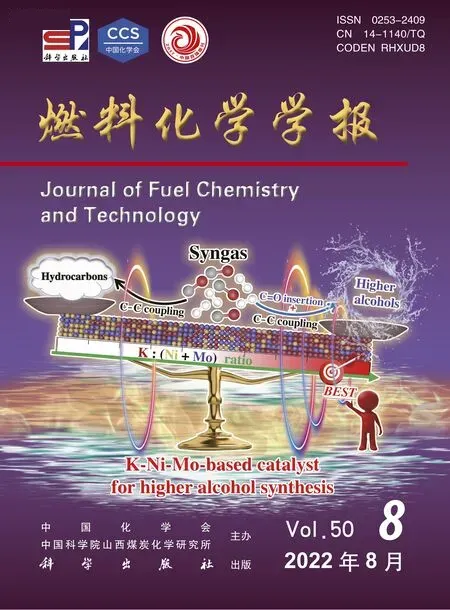Indium modified zirconia coupling with HZSM-5 for syngas conversion to aromatics
LIU Jing-ge ,YAN Guo-chun ,FANG Ke-gong ,ZHANG Cheng-hua,*
(1.China Shenhua Coal to Liquid and Chemical Co., Ltd., Beijing 100011, China;2.State Key Laboratory of Coal Conversion, Institute of Coal Chemistry,Chinese Academy of Sciences, Taiyuan 030001, China)
Abstract: Metal oxide-zeolite (OX-ZEO) bifunctional catalysts have been shown to have excellent aromatic selectivity and catalytic stability in syngas conversion; however, low CO conversion hinders their further development.In this paper, a series of In-ZrO2 bi-metallic oxides with In/Zr molar ratio ranging of 1/100-1/1 were prepared.After thoroughly investigated by Xray diffraction, transmission electron microscopy, N2 sorption, pyridine-adsorbed infrared spectroscopy, X-ray photoelectron spectroscopy, electron paramagnetic resonance and temperature programmed desorption technologies, we found that introduction of indium has significantly influence on the catalytic performance due to the variation of sample’s physicochemical properties.Indium species was benefit to the dissociation of H2 that promotes CO activation.Nevertheless, it also induced the formation of more CH4.In-ZrO2 oxide with In/Zr ratio of 1/50 showed CO conversion of 18.2% with the selectivity of oxygenates of 86.4%.After combined with H-ZSM-5, In/Zr=1/50&H-ZSM-5 gave CO conversion of 46.5%with C5+ selectivity of 62.6% and the aromatic selectivity in C5+ reached 93.4%.However, the catalytic stability of this bifunctional catalyst was gradually decreased due to the aggregation of indium atoms.
Key words: OX-ZEO;syngas;aromatics;In-ZrO2 bi-metallic oxide
Aromatics are important basic chemical materials and constitute one-third of the commodity in petrochemical market.Aromatics are mainly derived from naphtha reforming or oil-thermal cracking[1,2].However, with the depletion of oil resources, it is necessary to find a sustainable aromatics synthesis route.Using the bifunctional catalyst, syngas can be directly transferred into aromatics (STA) that shows great potential for industrial application[3-10].
According to the reaction mechanism, bifunctional catalyst can be distinguished into the metal oxide &zeolite system (OX-ZEO, metal oxide as hydrogenation phase)[3-6]and the F-T & zeolite system (Fischer-Tropsch catalyst as hydrogenation phase)[7-10].Due to the excellent catalytic stability and aromatic selectivity, OX-ZEO system attracts much more attention.In the OX-ZEO system, ZrO2has been widely used as hydrogenation phase, due to its intrinsic ability for CO isomerization[11]and aromatization[12].However, the catalytic activity of ZrO2for CO conversion is quite low.Many efforts have been carried out to solve this problem, such as hetero-element introduction or surface acidity modification: Watcharapong et al.[13]doped ZrO2with CeO2for CO isomerization, the CO conversion raised from 2.9% of ZrO2to 7.4% of CeO2-ZrO2; Li et al.[14]suggested that introduction of Sm2O3or Al2O3onto ZrO2to enhance the surface acidity can effectively increase the CO conversion from 16.5% of ZrO2to 21.6% of Sm2O3-ZrO2or 25.9% of Al2O3-ZrO2[15].Moreover, impregnated ZrO2with sulfate was also benefit to the CO activation[16].For the STA reaction,CH3OH[3]andare the main intermediates,whereas the saturated paraffin is difficult to be cycled in the next reforming reaction[17].However, it usually generated large amounts of CH4at high CO conversion[13-16].
Recently, Cheng et al.[3]prepared the Zn-ZrO2&HZSM-5 bifunctional catalyst, which shows 20.0% CO conversion with 80.0% aromatic selectivity when Zn/Zr molar ratio is 1/200.Although the CO conversion can further increase to 45.0% at Zn/Zr of 1/5, the major products were saturated paraffin instead of aromatics with the total selectivity of CH4andreaching 60.0%.Zhou et al.[5]also suggested that Mo-ZrO2&H-ZSM-5 (Mo/Zr molar ratio of 1/68) shows 19.0% CO conversion with 72.0% aromatic selectivity.Similarly, the CO conversion was increased with the increase of Mo content, despite that more saturatedparaffin were generated.After 100 h stability test, some deactivation was observed on Mo-ZrO2&H-ZSM-5.According to the results of Refs.[3]and [5],introduction of hetero-element into ZrO2enhances the CO conversion of bifunctional catalyst, but produces more saturated paraffin.Meanwhile, it also has some influence on the catalytic stability[5].As far as we know, less research has been done on the causes of this phenomenon.
Recently, Mart in et al.[18]investigated the CO2hydrogenation to methanol over In2O3-ZrO2.In2O3-ZrO2showed 100.0% methanol selectivity with remarkable stability for 1000 h.Wang et al.[19,20]mixed In2O3-ZrO2with SAPO-34 for light olefin ()synthesis from CO2or CO hydrogenation.Both of the bifunctional catalysts in Refs.[19]and [20]exhibited excellentselectivity and catalytic stability,confirming that introduction of indium into ZrO2could obviously promote CO conversion.It was shown that the hydroxyls, oxygen vacancies (VO), coordinative unsaturated Zr-O pairs and Lewis acid sites (Zr3+, Zr4+)on the surface of ZrO2are the main active sites for CO activation[21].Priscila et al.[22]pointed out that the interdiffusion between In2O3and ZrO2can induce the formation of VO.Therefore, indium was used to enhance the activity of ZrO2for CO hydrogenation.
In this paper, we prepared various In-ZrO2bimetallic oxides with the In/Zr molar ratio from 1/100 to 1/1 through hydrothermal method.The structure and electronic property of these catalysts were investigated by X-ray diffraction (XRD), N2sorption, pyridineadsorbed infrared spectroscopy (Py-IR), temperature programmed desorption of carbon monoxide (COTPD), temperature programmed desorption of hydrogen (H2-TPD), temperature programmed reduction of hydrogen (H2-TPR), temperature programmed hydrogenation (TPH), X-ray photoelectron spectroscopy(XPS) and electron paramagnetic resonance (EPR).In-ZrO2&H-ZSM-5 bifunctional catalysts were then prepared by physical mixture of In-ZrO2bi-metallic oxides with H-ZSM-5 for conversion of syngas into aromatics.
1 Experiments
1.1 Catalyst preparation
All chemicals were obtained from Aladin and without further purified.H-ZSM-5 zeolite (Si/Al ratio= 80) was purchased from Nankai University catalysts company.Before catalytic evaluation, zeolite was calcined in static air at 400 °C for 4 h.
The In-ZrO2bi-metallic oxides were synthesized from hydrothermal method: urea, zirconyl nitrate and indium nitrate were solved into 80 mL deionized water(the concentration of In3+and Zr4+was 0.4 mol/L, the molar ratio of urea/(Zr4++ In3+) was fixed at 10).After stirred, the solution was transferred into Teflon-lined autoclave and heated in thermostatic oven at 180 °C for 24 h.The obtained white precipitate was washed with the deionized water until to the pH = 7 and it was then dried in thermostatic oven at 120 °C for 12 h and calcined in tube oven at 400 °C for 9 h.The obtained sample was defined asm-ZrO2, In/Zr = 1/1, 1/5, 1/10,1/25, 1/50, 1/100 (representing the molar ratio of In and Zr) andc-In2O3.
In-ZrO2&H-ZSM-5 bifunctional catalyst was prepared by physical mixture of the powders of In-ZrO2and H-ZSM-5 with the mass ratio of 2∶1, which was then pressed, crushed and sieved to granules of 20-40 mesh.
1.2 Catalyst characterization
The phase and morphology of each sample were investigated by powder X-ray diffraction (XRD) and transmission electron microscopy (TEM) respectively.XRD was recorded on a BRUKER D2 PHASER diffractometer with a CuKα radiation (30 kV, 10 mA).The proportion ofm-ZrO2andt-ZrO2in different sample was estimated by comparing Gaussian areash ×w (handware the height and the half-width of diffraction peaks in XRD) of peaks at 2θ= 28° (form-ZrO2) or 2θ= 30° (fort-ZrO2).TEM was performed on FEI Talos Tecnai G2 F30 with a 200 kV accelerating voltage.
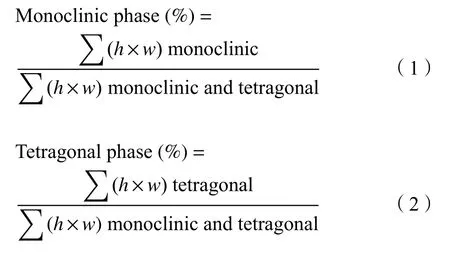
The texture properties of each sample were investigated by N2sorption on a Micromeritics-ASAP 2420 apparatus at -196 °C.The specific surface areas and the pore volumes of each sample were calculated by the BET and the BJH equations respectively.
Pyridine-adsorption infrared spectroscopy (Py-IR)was used to evaluate the acidic properties of various samples and it was carried out on an EQUINOX 70.The sample was compressed in the FT-IR cell and degassed in vacuum of 10-2Pa at 400 °C for 2 h.Then,the sample was saturated with pyridine vapor at 30 °C for 10 min.After equilibration, the sample was evacuated at 200 °C and 350 °C to remove the excess pyridine molecules.FT-IR spectra was recorded in the range of 400-4000 cm-1.
X-ray photoelectron spectroscopy (XPS) and electron paramagnetic resonance (EPR) were used to investigate sample’s surface properties.XPS and EPR were performed on a Thermo Scientific K-alpha using AlKα (hv= 1486.6 eV) as an X-ray source and on a Bruker Xenon respectively.The parameters for measurements were listed as follows: microwave frequency 9.5 GHz, microwave power 20 mW,modulation frequency 100 kHz, attenuator 10 dB.
Temperature programmed desorption of hydrogen(H2-TPD) or carbon monoxide (CO-TPD) were conducted on AutoChem II 2920.Firstly, 100 mg ZrO2was reduced at 400 °C for 1 h under H2atmosphere.It was then cooled down to 50 °C under Ar or He(50 mL/min) flow and 5% H2/Ar or 10% CO/He flow(50 mL/min) was adsorbed.After that, the physical adsorbed H2or CO was removed by Ar or He(50 mL/min) for 1h, then the sample was heated with a rate of 10 °C/min.The signals were recorded by a TCD detector and the effluent was detected by a Pfeiffer Omnistar Quadrupole mass spectrometer (H2-TPD∶m/z= 2 and CO-TPD∶m/z= 28).
Temperature programmed reduction of hydrogen(H2-TPR) was performed on Micromeritics AutoChem II 2950.Firstly, about 20 mg sample was loaded into a U-type quartz tube reactor and ramped from 50 to 800 °C under 10% H2/Ar (50 mL/min).The signal was recorded by a TCD detector.Isopropyl alcohol was used to remove water.
Temperature programmed hydrogenation (TPH)was conducted on Micromeritics AutoChem II 2920.50 mg sample was placed in a U-type quartz tube reactor and it was then reduced under pure H2flow(50 mL/min) at 350 °C for 1 h.After the temperature cooled to 50 °C in the Ar atmosphere, syngas (H2/CO =1/1) was purged and ramped to the 800 °C with a rate of 10 °C/min.The signals were recorded by a TCD detector and the effluent was detected by a Pfeiffer Omnistar Quadrupole mass spectrometer simultaneously(m/z= 15).
1.3 Catalyst evaluation
The catalytic performance was tested in a fixedbed stainless steel tubular reactor.Typically, catalyst(20-40 mesh) was placed in the isothermal zone and the remaining volume of the tube was filled with quartz granules (20-40 mesh).The gaseous products were detected online by a Gas chromatography (GC)(models 7890B; Agilent) equipped with a TCD detector and two FID detectors.TCD was connected with a PLOT Q column (30 m×0.53 mm) and a molecular sieve 5 A column to analyze H2, CO2, CO and CH4; front FID was connected with a HP-PONA column to detect hydrocarbons with carbon number higher than 4; back FID was connected with a GasPro column (25 m×0.32 mm) to detect C1-4hydrocarbons and dimethyl ether (DME).The wax phase products were collected in the hot trap (kept at 150 °C) and that in the oil/water phase was separated in the cold trap(kept at 1 °C).All the products in hot or cold trap were analyzed off-line.
2 Results and discussions
2.1 Phase and morphology
XRD:XRD patterns ofm-ZrO2, In-ZrO2bimetallic oxides andc-In2O3were shown in the Figure 1(a).A typical phase transfer was observed with the increase of indium content.Form-ZrO2, In/Zr =1/100 and 1/50, the diffraction peaks at 2θof 28.2°,31.5°, 34.2° and 35.3°, attributed tom-ZrO2’s (-111),(111), (200) and (002) planes, were detected[23].When the In/Zr molar ratio is increased to 1/25,m-ZrO2andt-ZrO2phases were co-existed and the peaks at 2θof 30.2°, 35.0°, 50.4°, 60.0° and 62.9° were indexed as the (101), (110), (112), (211) and (202) planes oft-ZrO2[23].Based on the Equation (1) and Equation (2),the proportion of each phase in In-Zr=1/25 was calculated and listed in the Table 1.Further increasing the indium content to In/Zr = 1/10 and In/Zr = 1/5, nom-ZrO2was found andt-ZrO2became the major phase.This is in line with the observation of Jong et al.[24]that a small number of rare-earth elements in ZrO2could stabilize the tetragonal phase structure in a wide range of temperature.This phase transfer phenomenon was also observed by Cheng et al.[3]on Zn-ZrO2bi-metallic oxide.For In/Zr = 1/1 andc-In2O3, the peaks at 2θ=21.5°, 30.5° 35.5°, 51.0° and 60.7° can be ascribed to thec-In2O3’s (211), (222), (400), (611) and (622)planes[25].After magnifying the peaks at 28.0°-32.0°, it was found that the diffraction peak was slightly shifted towards higher angle from In/Zr = 1/10 to purec-In2O3(shown in the Figure 1(b)).This suggests the lattice shrinkage of In-ZrO2bi-metallic oxides, which is caused by the partial replacement of In3+cations (0.94 Å) with smaller radius Zr4+cations (0.84 Å), thus forming In-ZrO2solid solution[26].
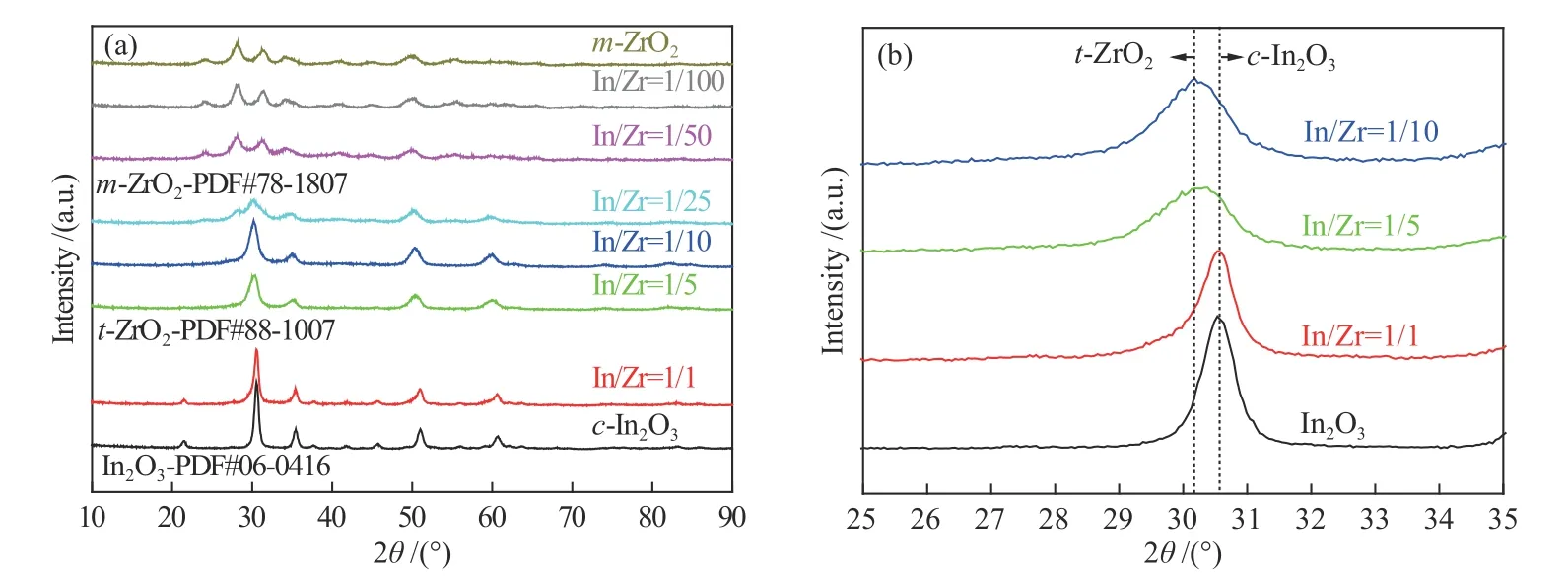
Figure 1 XRD patterns of In-ZrO2 bi-metallic oxides with different In content:(a) 2θ diffraction peak in the range of 10°-90° and (b) 25°-35°

Table 1 Texture properties of In-ZrO2 bi-metallic oxides with different In content
TEM:TEM images ofm-ZrO2, In/Zr = 1/5, 1/10,1/25, 1/50 andc-In2O3were displayed in the Figure 2(a)-(f).The particle sizes were estimated by counting more than 200 NPs with the Nano Measure software.All them-ZrO2and In-ZrO2bi-metallic oxides showed the mean size in the range of 7.0-9.0 nm, consistent with the results of XRD (listed in the Table 1), indicating that these samples were highly dispersed.In contrast,the particle size ofc-In2O3reached 15.0-20.0 nm due to its aggregation during calcination.With the increase of indium content, the morphology of catalyst was changed from spherical particles (m-ZrO2, In/Zr = 1/50,1/25, 1/10 and 1/5) to the hexagon structure (c-In2O3).Noticeably, some pores were detected on the surface ofc-In2O3(as shown in the Figure 2(f)).
HRTEM was applied to investigate crystal properties of samples.Blue, yellow and white lines in the Figure 2(a)-(f) represented the lattice fringes ofc-In2O3,t-ZrO2andm-ZrO2respectively.The phase transfer phenomenon can be directly observed in the HRTEM images.Form-ZrO2(as shown in the Figure 2(a)), lattice fringes of 3.16, 3.64 and 5.08 Å were ascribed to the [-111], [110]and [100]planes ofm-ZrO2.Similarly, only [-111]plane ofm-ZrO2with lattice fringe of 3.12-3.16 Å was observed on In/Zr = 1/50.Further increasing the amounts of indium leaded to the co-existence ofm-/t-ZrO2andc-In2O3.For In/Zr = 1/25 (as shown in the Figure 2(c)), the lattice fringes of 2.62, 5.07, 2.94-2.97 and 2.93-2.94 Å, corresponding to them-ZrO2[002],m-ZrO2[100],t-ZrO2[222]andc-In2O3[211]planes respectively were clearly visible, whereas for In/Zr = 1/10 (as shown in the Figure 2(d)), lattice parameter in 2.48, 3.16, 2.59 and 2.91 Å, attributing to them-ZrO2[-102],m-ZrO2[-111],t-ZrO2[002]andc-In2O3[222]planes respectively, was detected.The lattice fringes ofm-ZrO2disappeared and onlyt-ZrO2[111]andc-In2O3[222]can be found on In/Zr = 1/5.For the purec-In2O3,only the lattice parameter of 1.79, 2.39, 2.90 and 4.13 Å,corresponding to thec-In2O3’s [411], [222], [440]and[211]planes, existed.HRTEM gave similar results as that of XRD characterization: the phase structure of ZrO2is gradually transformed from monoclinic phase into tetragonal phase when In/Zr molar ratio higher than 1/25; the relative proportion ofm- andt-ZrO2in In/Zr = 1/25 was calculated to be 67.5% and 32.5%respectively.
TEM-mapping confirmed that indium and zirconium atoms were highly dispersed, despite that in the zirconium elements enriched region, indium elements showed some aggregation Figure 2 (b)-(e).Noticeably, element distribution morphology of indium and zirconium was consistent with the molar ratio in the samples.Based on the XRD and TEM characterizations, it can be inferred that In-Zr were highly dispersed and perhaps formed In-ZrO2solid solution.
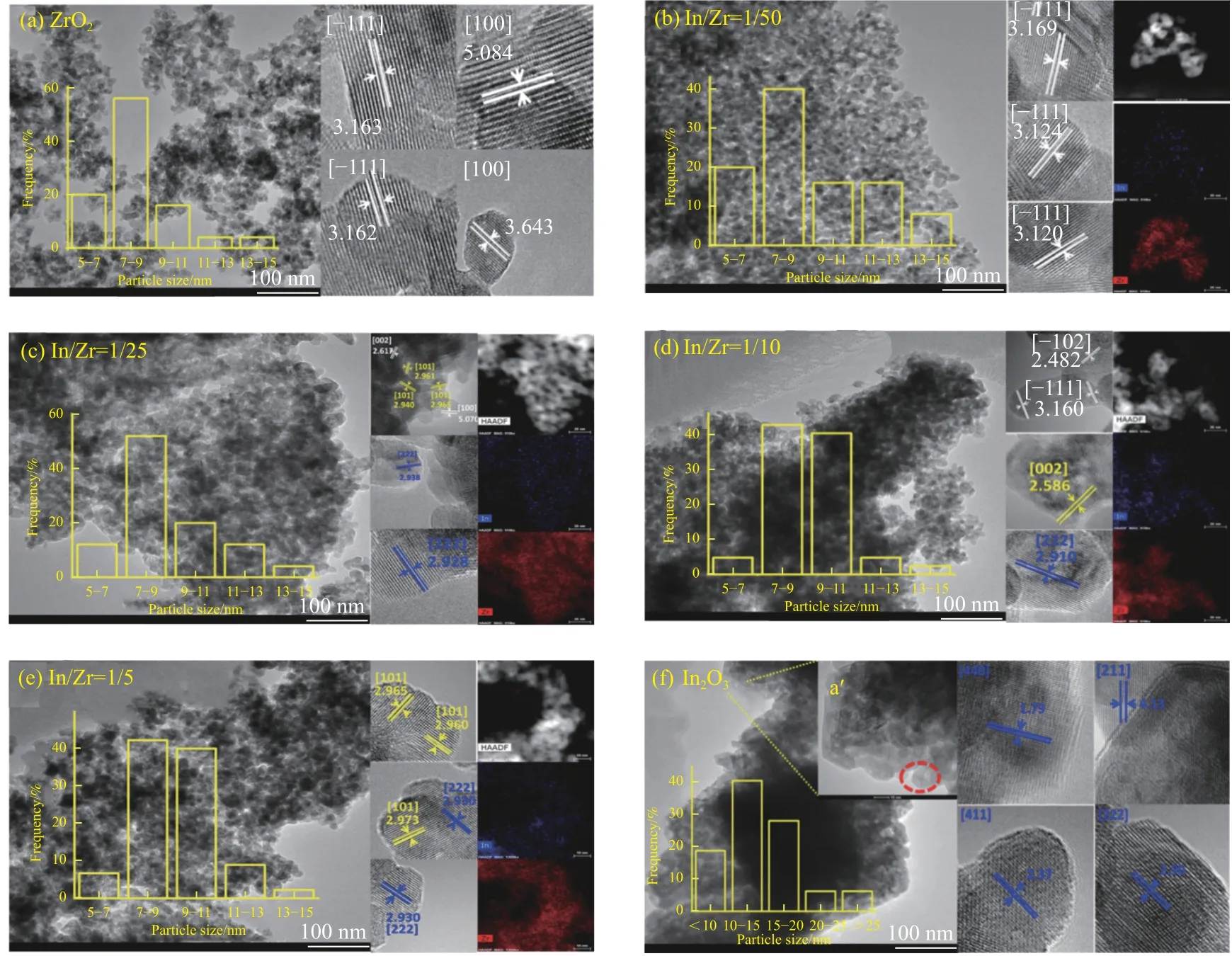
Figure 2 (a)-(f) TEM images of In-ZrO2 bi-metallic oxides with different indium content (blue: c-In2O3; yellow: t-ZrO2; white: m-ZrO2)
2.2 Texture property
N2 sorption:N2adsorption and desorption isothermals and pore size distribution of each sample were shown in the Figure 3(a) and (b) respectively, and the texture properties were listed in the Table 1.As shown in the Figure 3(a), all samples displayed typical IV isothermal with an H3-type hysteresis loop,indicating that In-ZrO2bi-metallic oxide possessed mesoporous structure, being in line with the results of pore size distribution in Figure 3(b).However, the H3-type hysteresis loop was gradually narrowed with the increases of indium content, due to the presence of irregular particles in the pores[27].According to the results of TEM, In/Zr = 1/1 andc-In2O3aggregated during calcination that would lead to the loss of porous structure.Nevertheless, some meso-/macropores still existed (as shown in the Figure 2(f)).Such a phenomenon caused the variation of samples’ texture properties.The specific area (Sbet) decreased from 98 m2/g ofm-ZrO2’s to 14 m2/g ofc-In2O3, along with the increase of crystal size from 7.0 nm ofm-ZrO2to 14.2 nm ofc-In2O3.
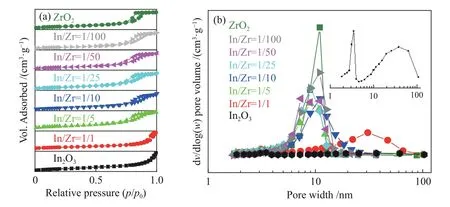
Figure 3 (a) N2 adsorption-desorption isotherms and (b) pore size distribution of In-ZrO2 bi-metallic oxides with different indium content
2.3 Surface property
Surface acidity:The acid sites on the surface of ZrO2played an important role in CO activation.In this part, Py-IR was used to investigate the acidic properties of In-ZrO2bi-metallic oxides as shown in Figure 4.All the samples showed the bands at 1445, 1486, 1574 and 1605 cm-1, which are attributed to the interaction of pyridine with Lewis acid sites; no Brønsted acid sites was detected[28,29].The acid amount decreased from 70 μmol/g ofm-ZrO2to 5.6 μmol/g of In/Zr = 1/10, with the increase of In content.According to the desorption temperature of pyridine, the In-ZrO2bi-metallic oxides contained weak (30 °C), medium (200 °C) and strong acid sites (300 °C)[28].As shown in the Table 2, the relative content of strong acid sites also decreased from 17.8% ofm-ZrO2to 12.0% of In/Zr = 1/25, and even could not be detected when In/Zr>1/25).

Table 2 Py-FTIR results of In-ZrO2 bi-metallic oxides with different In content
Surface defects:Surface properties of samples were analyzed using XPS and EPR.In the In 3dXPS(Figure 5(a)), the binding energy at 444.0 and 452.5 eV were attributed to the In 3d3/2and 3d5/2orbit respectively[20-30], whereas in the Zr 3dXPS(Figure 5(b)), the binding energy at 184.4 and 182.0 eV were ascribed to the Zr 3d3/2and 3d5/2orbit respectively[31,32].It should be noted that the Zr 3dorbit was slightly shifted to lower binding energy inm-ZrO2,In/Zr = 1/100 and 1/50, suggesting the formation of VO[33-35].This can be verified by EPR that the signal in the range of 3420-3400 G, corresponding to the g =1.98, indicated the existence of VO(as shown in the Figure 5(c))[36,37].According to the signal intensity,m-ZrO2possessed the most abundant VO, and the content of VOwas gradually decreased with the increase of In content and nearly no the signal of VOwas detected onc-In2O3.As pointed out by Silva-Calpa et al.[38]this may be because although hetero-element instruction increased oxygen mobility, the oxygen coming from inner layers may quickly fill oxygen vacancy, thus decreasing the number of oxygen vacancy.
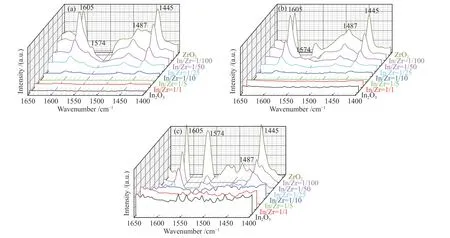
Figure 4 Py-FTIR results of In-ZrO2 bi-metallic oxides with different indium content at (a) 30 °C, (b) 200 °C and (c) 300 °C

Figure 5 Surface defects of In-ZrO2 bi-metallic oxides with different In content obtained from(a) In 3d orbit, (b) Zr 3d orbit and (c) EPR results
2.4 Catalytic evaluation
Single metal oxide:For the OX-ZEO bifunctional catalyst, the metal oxide serves as hydrogenation phase for CO activation, while zeolite is used to the aromatization of various intermediates.Although the conversion of intermediates to aromatics on zeolite can also in turn promote the activation of CO conversion[3-10], zeolite itself was disabled for the syngas activation and the intermediates formation.Therefore, the catalytic performance of OX-ZEO mainly depended on hydrogenation phase.The catalytic results of various metal oxides were then investigated and listed in the Table 3.

Table 3 Catalytic properties of In-ZrO2 bi-metalli c oxides with different In content
It was found thatm-ZrO2andc-In2O3showed low catalytic activity, with CO conversion of only 8.0% and 0.2% respectively.However, the CO conversion of In-ZrO2bi-metallic oxides was significantly increasedfrom 15.9% of In/Zr = 1/100 to 29.2% of In/Zr = 1/1.Nevertheless, it also produced more CH4with the selectivity increase from 9.1% of In/Zr = 1/100 to 81.0% of In/Zr = 1/1.In contrast, the selectivity of oxygenates (including CH3OH and CH3OCH3) dropped from 90.4% of In/Zr = 1/100 to 18.2% of In/Zr =1/1.In the previous work, we proposed that CO was adsorbed on the surface of ZrO2and then hydrogenated into oxygenates; meanwhile, these oxygenates could also be dissociated into C* under H assistance[31].So, the ability of In-ZrO2bi-metallic oxide for CO/H2activation was deeply investigated.
CO-/H2-TPD and TPH characterizations were used form-ZrO2, In/Zr=1/1, 1/25, 1/50 andc-In2O3samples and the results were shown in the Figure 6(a)-(c).In CO-TPD,m-ZrO2showed a weak CO desorption peak at around 300-350 °C, which can not be observed on the samples of In/Zr = 1/50 or 1/25.This may be due to the decrease of the amount of acid sites and VOthat weakened their CO adsorption ability.An apparent CO desorption peak was detected on In/Zr = 1/1, while it disappeared onc-In2O3during CO-TPD.Sato et al.[33]pointed out that ZrO2could hardly adsorb H2, thus no H2desorption peak was detected in H2-TPD onm-ZrO2.After incorporation of In, the adsorption of H2was enhanced, as a broadened H2desorption peak was visible on In/Zr = 1/50, 1/25 and 1/1.Meanwhile, H2desorption temperature exhibited a volcanic trend over these samples.
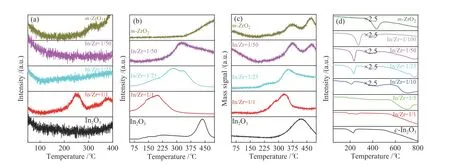
Figure 6 (a) CO-TPD, (b) H2-TPD, (c) TPH and (d) H2-TPR results of In-ZrO2 bi-metallic oxides with different In content
The results of CO-/H2-TPD suggested that introduction of In significantly influenced the ability of In-ZrO2bi-metallic oxides for CO and H2activation.The CO hydrogenation activity was further evaluated by TPH.As shown in the Figure 6(c), CO hydrogenation temperature decreased from 375 °C ofm-ZrO2to 300 °C of In-Zr = 1/1, and it further increased to 375 °C onc-In2O3.Finally, the reduction behavior of all the samples was investigated by H2-TPR.As shown in the Figure 6(d), an apparent H2consumption peak was detected at around 400 °C.Zhou et al.[39,40]pointed out the reduced temperature of ZrO2was higher than 600 °C.In this case,m-ZrO2with small particle size of 7.0 nm (as shown in the TEM)and abundant crystal defects may be beneficial for the reduction.The reduction temperature ofc-In2O3was only 200 °C.After formation of In-ZrO2bi-metallic oxides, the reduced temperature was between 200 and 300 °C.Based on the TPR results, we could infer that part of the In-ZrO2bi-metallic oxides will be reduced during reaction (c-In2O3could be reduced at 100-200°C in H2or syngas atmosphere[22,25]), and the generated metal In promoted the activation of H2.Therefore, H2desorption temperature significantly decreased in H2-TPD.The produced active H (H*) also elevated the CO conversion from 8.0% ofm-ZrO2to 25.2% of In/Zr =1/1.Meanwhile, more CH4were also generated due to the dissociation of some oxygenates under H2assistance.According to the results of CO-/H2-TPD,the low CO conversion of only 0.2% onc-In2O3mainly ascribed to the weak ability for CO and H2activation,which makes the CO hydrogenation temperature onc-In2O3higher than 375 °C.
OX-ZEO:As shown in Table 3, In/Zr = 1/50 possessed 18.2% CO conversion and 86.4% oxygenates selectivity, with the CO2selectivity of only 33.0%, so we chose In/Zr = 1/50 as hydrogenation phase in OXZEO bifunctional catalyst for syngas aromatization.The catalytic performance of OX-ZEO was shown in the Figure 7.The In/Zr = 1/50&H-ZSM-5 bifunctional catalyst showed 23.2% CO conversion with 52.4% C5+selectivity (aromatic selectivity in C5+of 92.2%) at350 °C.When the reaction temperature was raised to 400 °C, CO conversion reached 46.5% with 62.6% C5+selectivity (aromatic selectivity in C5+of 93.4%).High reaction temperature was benefit to elevate the CO conversion and promote the intermediate aromatization;the C2-4selectivity decreased from 34.5% at 350 °C to 21.5% at 400 °C)[41,42].However, a catalyst deactivation occurred during 80 h stability test: at 350 °C, CO conversion gradually dropped from 28.3% to 20.6%during first 30 h; when the reaction was carried out at 400 °C, the CO conversion decreased from 51.0% to the 43.7% during the next 50 h.A similar phenomenon was also observed by Zhou et al.[5]on Mo-based bifunctional catalyst, due to the sintering of Mo during reaction.

Figure 7 Catalytic performance of In/Zr = 1/50&H-ZSM-5 bifunctional catalyst in syngas to aromatic reaction conditions: 6 MPa, H2=CO = 30 mL/min
3 Conclusions
In summary, a series of In-ZrO2bi-metallic oxides with In/Zr molar ratio ranging from 1/100 to 1/1 were prepared.The results of characterizations indicated that incorporation of In significantly influenced the crystal phase, morphology and texture properties of In-ZrO2bi-metallic oxides.The crystal phase of In-ZrO2gradually transformed from monoclinic into tetragonal phase with increase of In content.Meanwhile, the particle size of In-ZrO2also enlarged from 7.5 nm of In/ZrO2= 1/100 to 13.4 nm In/ZrO2= 1/1.These induced the variation of the surface properties of sample.Introduction of In weakened the surface acidity and decreased the surface defects amount, but promoted the activation of H2, thus improving the CO conversion and generating more CH4.In/Zr = 1/50 showed 18.2% CO conversion with 86.4% oxygenates selectivity.After combined with H-ZSM-5, the In/Zr =1/50&H-ZSM-5 bifunctional catalyst exhibited 46.5%CO conversion with 62.6% C5+selectivity (aromatic selectivity in C5+reached 93.4%).The catalyst deactivation occurred during 80 h stability test,probably causing by the In atoms sintering.
Acknowledgments
Thanks Synfuels China Co., Ltd for the supports from capital and equipment.

